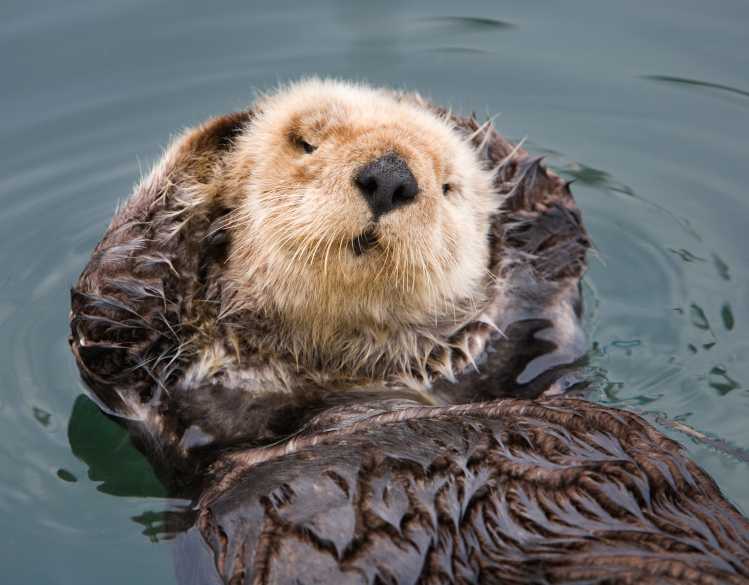
Put Your Sea Otter Knowledge to the Test
- Species conservation
- Natural history
You already know southern sea otters are cute and charismatic, but how well do you know this threatened species? Put your knowledge to the test. Click “Show More” to reveal the answer!

In terms of scientific classification, what family are sea otters a member of?
Southern sea otters are members of the weasel or mustelid family.
Like other members of this family, they have very thick fur. In fact, at nearly one million hairs per square inch, sea otters have the thickest fur of all mammals. Their fur consists of two layers that traps air and keep their skin dry—a vital adaptation for a marine mammal without blubber to keep them warm.
You can help the next otter in need when you adopt a past patient.
About how much does a sea otter eat in one day?
Sea otters can eat 25 to 30 percent of their body weight in one day.
That’s as if a 175-pound human ate 45 pounds of food in one day! Sea otters have a fast metabolism and need to eat a lot to maintain a healthy body weight and keep up with the physical demands of swimming. At our hospital, many sea otter patients get a nutritious diet of seafood delicacies like squid, shrimp, crab and sea urchins.


Where are southern sea otters found?
Southern sea otters can be found along California’s central coast, from Half Moon Bay to Point Conception.
There is a population of northern sea otters in Alaska as well as down the coast of British Columbia and Washington state. As a coastal species, sea otters prefer areas with kelp, which they use as an anchor by wrapping themselves in it when resting. Sea otter mothers also use kelp to keep their baby safe. When she leaves to go find food, she will wrap her baby in kelp, leaving it to bob on the surface like a cork.
You can help the next otter in need when you adopt a past patient.
Yes, I want to save a life!

Yes, I want to save a life!
You’ll be giving sick and injured animals the best possible care at the Center’s state-of-the-art hospital. With your gift today, you are giving a patient a second chance at life in the wild.
See Our Latest News
{"image":"\/People\/Action\/Veterinary care\/cropped-images\/Harris_Green turtle_TMMC-0-0-1270-992-1767649941.jpg","alt":"Heather Harris","title":"Seattle Aquarium Awards Dr. Heather Harris With Prestigious Conservation Research Award","link_url":"https:\/\/www.marinemammalcenter.org\/news\/seattle-aquarium-awards-dr-heather-harris-with-prestigious-conservation-research-award","label":"In the News","date":"2026-01-05 04:48:00"}

Seattle Aquarium Awards Dr. Heather Harris With Prestigious Conservation Research Award
January 5, 2026
Read More{"image":"\/People\/Action\/Veterinary care\/cropped-images\/harris-teaching-tube-feeding-0-0-1270-992-1767650122.jpg","alt":"A veterinarian and two trained volunteers tube feed an elephant seal pup.","title":"Training College Students in Marine Mammal Health","link_url":"https:\/\/www.marinemammalcenter.org\/news\/training-college-students-in-marine-mammal-health","label":"News Update","date":"2026-01-05 04:48:00"}

{"image":"\/Animals\/Patients\/Harbor seals\/2013\/cropped-images\/hs-bogey-photo-by-Ingrid-Overgard-c-the-marine-mammal-center-382-0-2914-2276-1605061447.jpg","alt":"harbor seal Bogey","title":"Top Eco Friendly Valentine\u2019s Day Gifts","link_url":"https:\/\/www.marinemammalcenter.org\/news\/top-eco-friendly-valentines-day-gifts","label":"News Update","date":"2026-01-01 01:00:00"}

{"image":"\/Animals\/Patients\/Harbor seals\/2020\/cropped-images\/hs-barnwood-by-bill-hunnewell-c-the-marine-mammal-center-315-0-3299-2577-1607370547.jpg","alt":"harbor seal Barnwood","title":"Last-Minute Gift Guide \u2013 Top Gifts that Give Back to Marine Animals","link_url":"https:\/\/www.marinemammalcenter.org\/news\/last-minute-gift-guide","label":"News Update","date":"2025-12-18 01:00:00"}

Last-Minute Gift Guide – Top Gifts that Give Back to Marine Animals
December 18, 2025
Read More






